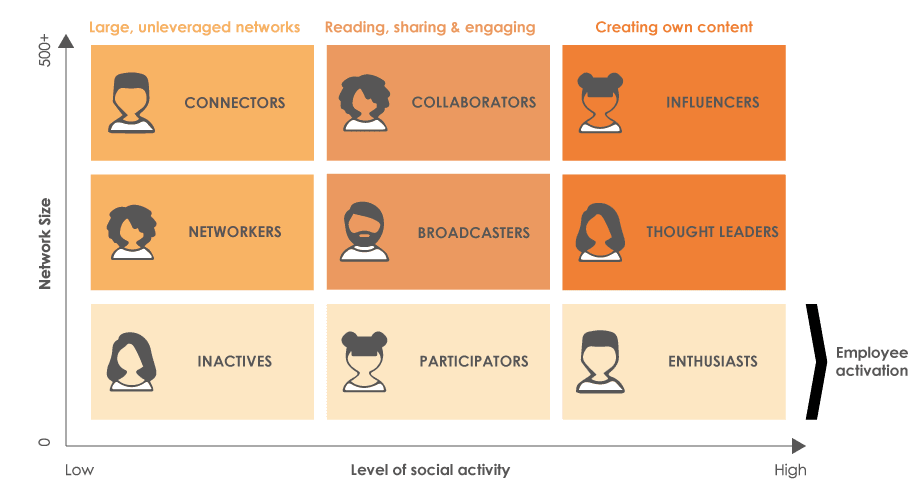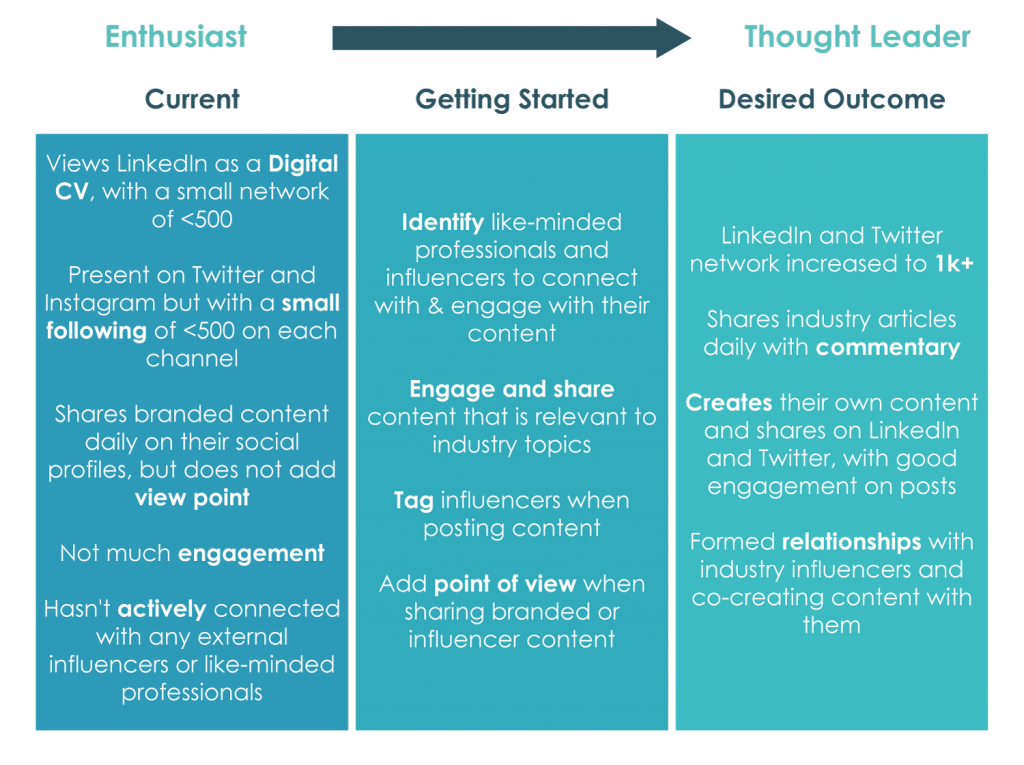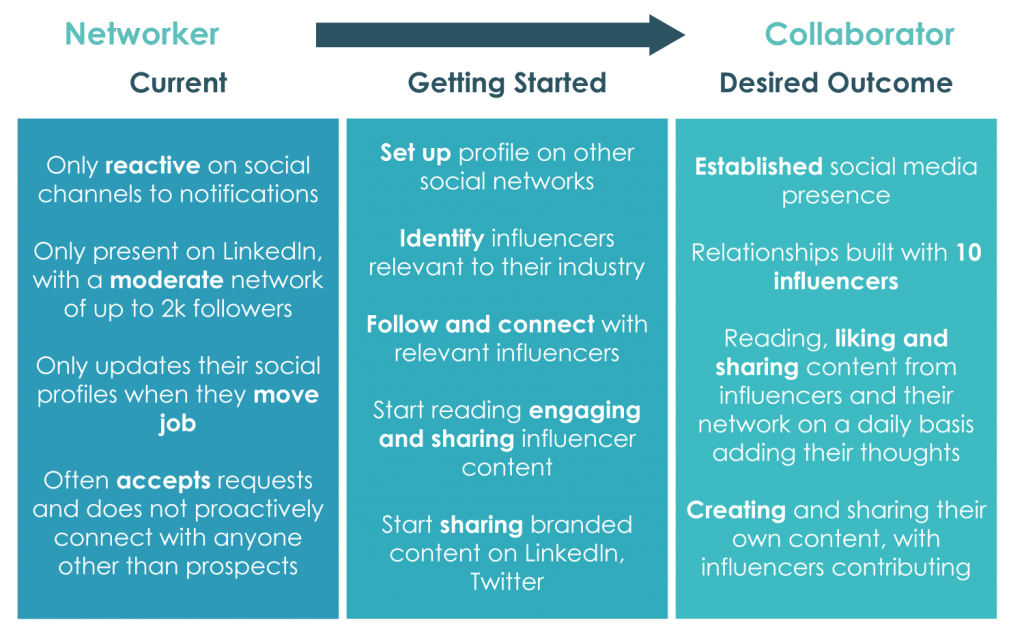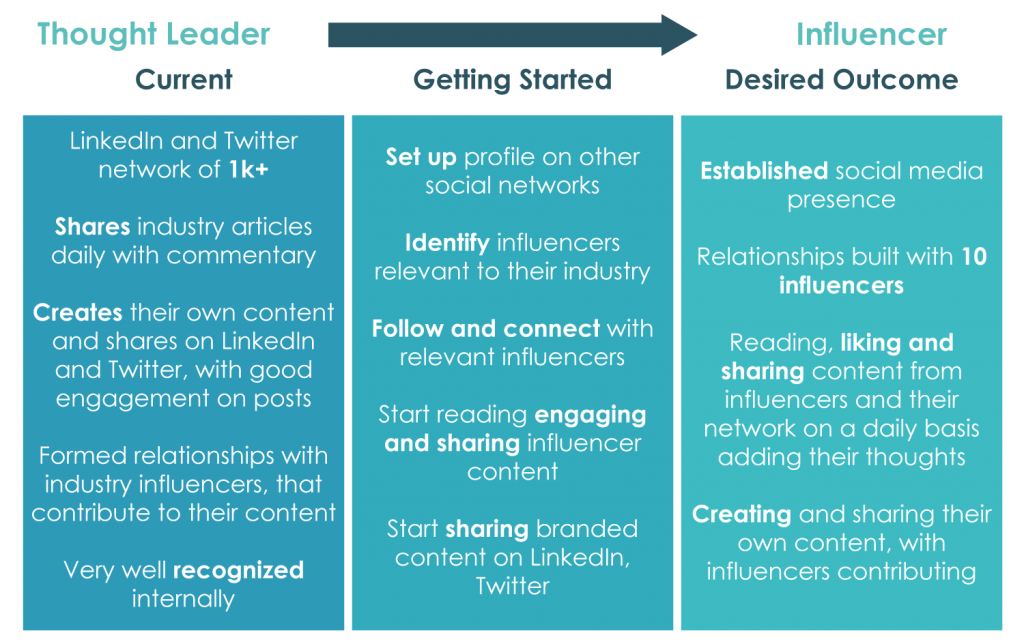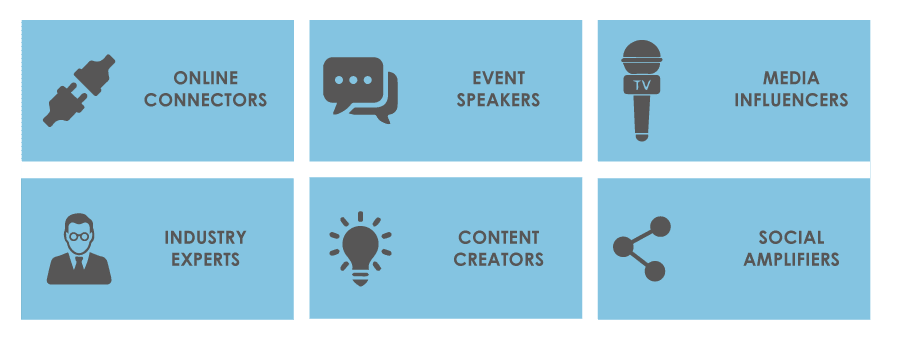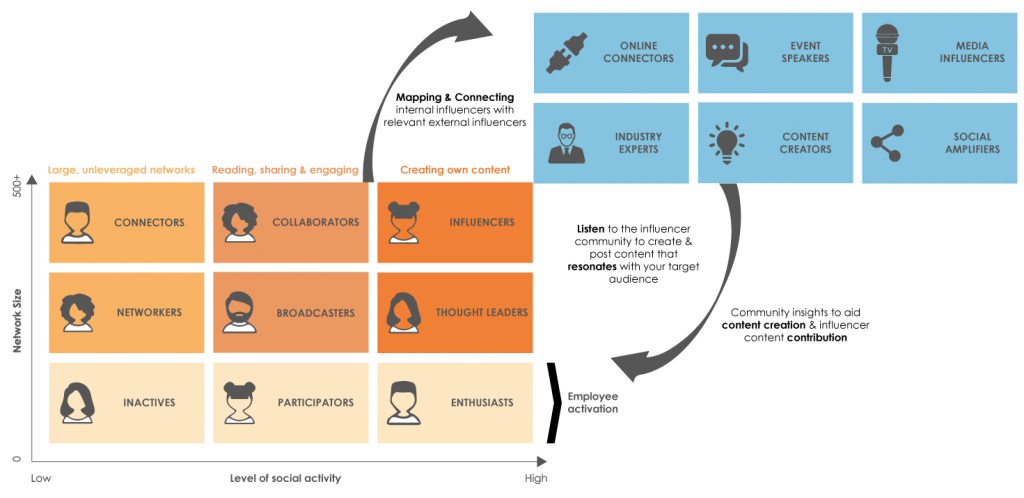The concept of your employees being influencers may sound odd to some. When most hear the term ‘influencer’ they think of the social media influencers on platforms such as Instagram, Twitter and YouTube endorsing consumer products to their audience in return for a pay cheque. Employees don’t quite fit this definition.
But if we actually take a step back, what do we really mean by the term ‘influencer’? Well, according to the Cambridge dictionary an influencer is ‘someone who affects or changes the way that other people behave, for example through their use of social media’; ‘a person or group that has the ability to influence the behaviour or opinions of others‘.
Now let’s look at what we mean when we use the term ’employee advocacy’. Consumers are increasingly trusting logos less and people more and this trust in PEOPLE is where Employee advocacy is so powerful. Your employees are your greatest asset; the ones behind the ‘everyday’ and therefore the most knowledgeable when it comes to talking about your products and services. They have the ability to speak about and advocate your brand with credibility and authenticity, as their audience trust and value their opinion. Employee advocacy is all about shifting the focus away from the brand itself and instead empowering your employees and giving them a platform to share their voice.
Now let’s look back at the definition of an influencer. They’re quite similar, no?
Ultimately, both influencer marketing and employee advocacy are all about the power and influence of people. The only difference is that your typical influencer is external to your brand, whereas your employees are internal.
Knowing how to help your employees become more influential is a win-win scenario where your employees can build their personal brand, all while increasing advocacy and coverage for your brand. Read on to learn how.

Download Employee Advocacy 2.0
Should all employees join the program?
This is a huge mistake that lots of brands make and something that I’d like to nip in the bud early. Too many brands decide that they want to start an employee advocacy program, and immediately see it as a project that will include all employees. This will not work. For one thing, this will make the program too large too quickly and create a much larger mountain to climb. You’re also going to struggle to on-board all employees which will make a perceived failure pretty much inevitable. On top of this, let’s assume all employees do join the program, not all employees’ hearts will be in it, so you won’t see the results you expect. As ever, quality over quantity.
Instead stick to those that show an interest in joining – they’re the ones that are going to be great brand advocates, and potentially influencers in the long term. As a rule of thumb, 10% of your workforce is a good place to start.
Can all employees be influencers?
In the same way that not all employees will want to join the program, not all employees will reach the ‘influencer’ stage. And this is absolutely ok. Tribal Impact have created this employee maturity model in which we can plot employees on a matrix depending on how large their audience is and their level of social activity.
What Employee Personas are there?
Persona | Description | Data-Led Analysis |
| Inactives | Do not have much of an online presence. LinkedIn is normally activated only when they are looking for a new job. May be very active on social networks that would be considered more personal e.g. Facebook and Instagram. |
|
| Networkers | Typically, more active on LinkedIn but no other platform other than personal social networks. They will often accept invitations online and may even occasionally send invitations to others. (a lot of sales people sit here). |
|
| Connectors | Large network on LinkedIn and always know someone who knows someone else who can help. They actively connect people together because they know that sharing is caring. |
|
| Participators | Relatively small network, they are beginning to dabble in social networking. They are testing the water by engaging with others online e.g. liking and commenting on content. |
|
| Broadcasters | Been “dabbling” for some time by engaging with other people’s content and are now starting to share other people’s content to their network. |
|
| Collaborators | Broadcast less and appreciate feedback more. Typically, employees in this space have a large network, they have been through the engaging and sharing stage and are now starting to formulate opinions themselves and seek to listen to others. |
|
| Enthusiasts | Highly active on social media. Anyone this far right on the model will be actively out there creating their own content and formulating their own opinions. However, they may have a relatively small network. |
|
| Thought Leaders | Considered the knowledge experts within an organization e.g. product marketing, pre-sales, sales consultants and they hold an enormous amount of credibility with customers. They do not actively network (often they don’t have time) but they may blog or tweet when they can. |
|
| Influencers | Highly active networkers and content creators. Social has become part of their daily routine – part of their DNA if you like. They are considered influencers in their field, formulating opinions and writing content that sets them apart from their peers. |
|
The Journey to Becoming an Influencer
Now the ideal, perfect path here is to move diagonally across to the right. But employee maturity journeys are rarely this linear. For example, it is ambitious to get an ‘inactive’ employee to go from having no audience and no social media activity to increasing both of these things simultaneously. In this case, the focus may be to first train them on how to create a profile and increase their social media activity to interact with other users, so that they’re a ‘participator’. From this increase in social activity with others, they may start to see their audience grow organically in time, helping them transition into more of a ‘broadcaster’, where they’re starting to not just engage with others, but they’re starting to read and share relevant content with their audience too. Once employees start seeing this kind of progress, it naturally encourages them to continue putting in the effort to reap yet more results.
Contrary to the above example, your typical salesmen that have social media profiles with audiences that are moderate in size but fairly un-leveraged, may be able to feasibly grow their audience while simultaneously increasing their level of social activity.
Some example evolutions:
Connecting employees with influencers
In the same way that brands working directly with influencers can help to increase brand awareness and amplify branded content, connecting your employees (internal influencers) with influencers (external influencers) can help them build their own networks, amplify their content and establish their professional brand.
In simple terms, connecting your employees to external influencers is a great way to accelerate your employees’ journeys to becoming influencers in their own right.
In order to effectively do this, follow these 4 steps:
Step 1: Map your influencers
In order to effectively connect your employees to relevant influencers, it is important to understand the different kind of influencer personas.
Influencer Definition | Description | Data-Led Analysis |
| Industry Experts | Professionals that have worked in industry who can influence key decision makers on a peer level. They have walked the walk, have high authority and very well engaged networks offline in niche topical areas. They often are authors or have published original research. They can be good event speakers, but this is not guaranteed. |
|
| Online Connectors | Influencers that have the most amount of connections and interactions online within a specific topical community. They are the people who you would want at a party to attract a larger crowd and therefore engaging them initially will help you collaborate with the longer tail. |
|
| Content Creators | People who create and publish original content or thoughts rather than simply sharing other people’s content online. Their content gets good engagement from their networks. |
|
| Event Speakers | Expert speakers that may or may not have a large online influence. Likely to have a presence on LinkedIn. They tend to have a large offline influence and get referenced a lot in news articles, blogs and forums. |
|
| Social Amplifiers | Present on most social platforms with large audiences with the ability to share content and make it viral. They normally have friends/peers in their network who will also help content become viral within a specific industry. |
|
Step 2: Define your employees’ personas
Using the employee evolution model and employee persona definitions, do an audit of your employees that have opted in to join the program. For a start, progress is much easier to achieve on both an individual level and a program level if you’re able to benchmark where you’re currently at. Different personas will also need training and motivating in different ways to reach the next level. We will cover all areas of motivation, training and enablement later on in the blog series.
After analyzing the employee personas, it is possible to gauge what influencer personas are most appropriate to connect with the employees. For example, an employee that falls into the ‘thought leader’ or ‘influencer’ category would be appropriate to connect and collaborate with a content creator, whereas the social sellers that are regularly at industry and networking events could connect with conference speakers to build relationships offline and online.
Step 3: Define your employees’ topical niche
Every employee is passionate and an expert at something that relates to their field and role. This is the basis upon which brands should connect well-aligned influencers. For example: connecting the marketing team with external marketing influencers.
Step 4: Listening to influencer community insights
This process goes beyond connecting employees with influencers, as it is also highly valuable for brands to monitor conversations amongst the influencer community to understand what topics are trending and resonating with their target audience. These insights can then be fed into the content creation strategy to ensure that you’re creating content that is going to resonate with your employees’ target audience. This also facilitates your employees to share great content that is going to increase their influence.
What do the experts have to say?

“Employees need training and guidance on how to ENHANCE their social presence, project their expertise, stimulate engagement, and value.”
Susan Emerick, Senior Manager Global Marketing & Advocacy at IBM

“More and more brands are transforming their employees into advocates, putting their marketing into the hands of staff. Working with colleagues enables leading brands to grow authentic brand awareness from the people who know their brand, products and services better than anyone. Employee advocates are the next generation of influencers.”
Caroline Jory, Engagement Director at Qubist

“Content adds value to the social media feeds of employees, whether they are social sellers or influencer marketing (and when I talk about influencers, I mean our 4500 employees who are influencers in their own micro-communities or sector spaces) then content is what drives the conversation.”
Keith Lewis, UK Social Media at Zurich Insurance

“As an Advocacy manager, I train our colleagues in the importance of personal branding and thought-leadership with the goal to create an army of thousands of micro-influencers with their own areas of expertise.”
Sonia Rosua-Clyne, Globsl Social Media at Sage

“I think that a big mistake that brands make is to fail to understand who their true influencers are, which I believe are their employees and their happy customers – those two groups of people make up your very best brand ambassadors.”
Melonie Dodaro, CEO of Top Dog Social Media

“People trust people. If done right, employees can be activated to be brand storytellers and influence others through the purchase funnel.”
Michael Brito, EVP at Zeno Group

“These days, if you want to be seen on social media without paying for an advertisement you need to be working with influencers and I think that employee advocacy also becomes part of the infrastructure and part of a mainstream marketing spend just like influencer marketing and obviously there is that overlap with “employee as influencer”.”
Neal Schaffer, CEO at PDCA Social

“As you encourage more employees to create content, you’ll generate more influencers within the market. Credible spokespeople that buyers trust. This is when you can start connecting your employee influencers to external influencers – influencer marketing that’s more human and authentic.”
Sarah Goodall, Founder at Tribal Impact
To learn more about how you can integrate your influencer marketing and employee advocacy programs, download the full Employee Advocacy 2.0 guide below.

Download Employee Advocacy 2.0
TAGS
Employee Advocacy 2.0
Leveraging influence to drive a connected organisation and employee-led buyer journey
Download this free report to learn how to integrate Influencer Marketing, Employee Advocacy and Social Selling into one advocacy program.

